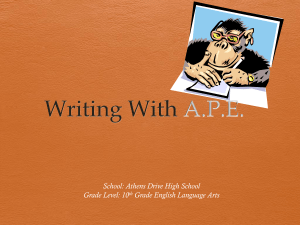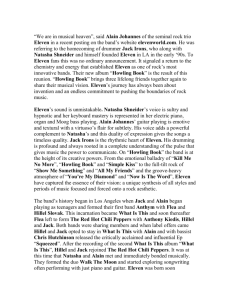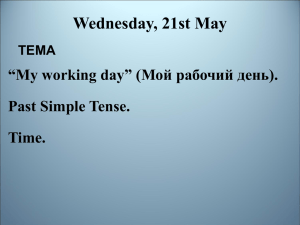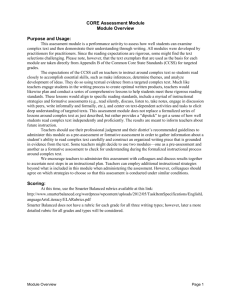Eleven - Ed Partners
advertisement
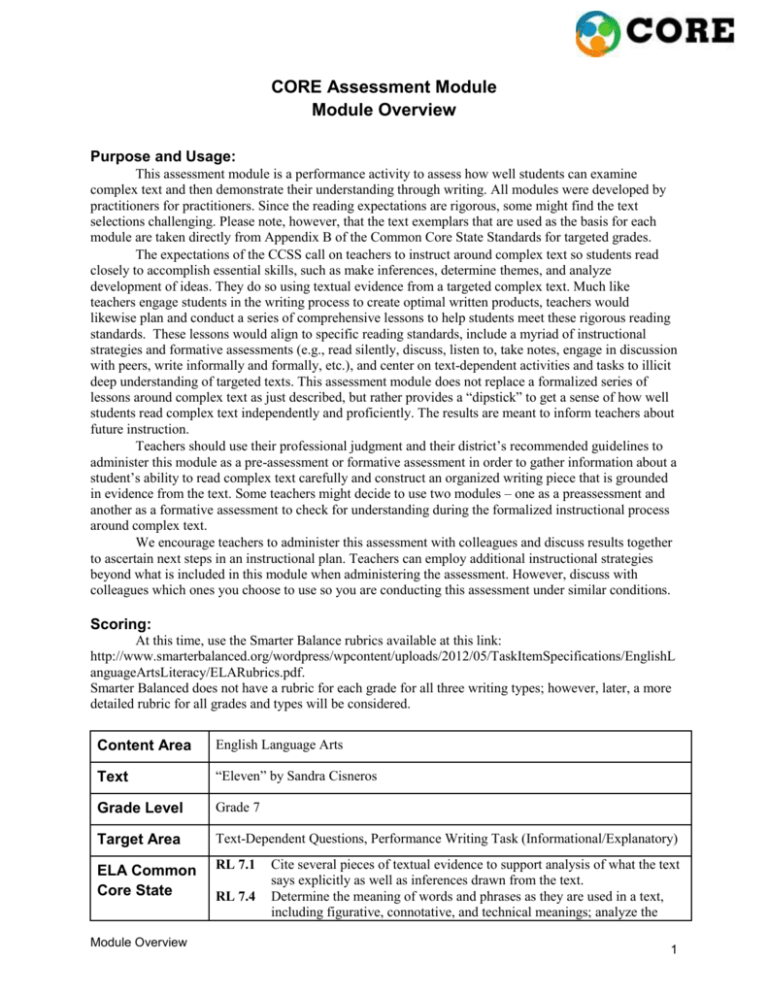
CORE Assessment Module Module Overview Purpose and Usage: This assessment module is a performance activity to assess how well students can examine complex text and then demonstrate their understanding through writing. All modules were developed by practitioners for practitioners. Since the reading expectations are rigorous, some might find the text selections challenging. Please note, however, that the text exemplars that are used as the basis for each module are taken directly from Appendix B of the Common Core State Standards for targeted grades. The expectations of the CCSS call on teachers to instruct around complex text so students read closely to accomplish essential skills, such as make inferences, determine themes, and analyze development of ideas. They do so using textual evidence from a targeted complex text. Much like teachers engage students in the writing process to create optimal written products, teachers would likewise plan and conduct a series of comprehensive lessons to help students meet these rigorous reading standards. These lessons would align to specific reading standards, include a myriad of instructional strategies and formative assessments (e.g., read silently, discuss, listen to, take notes, engage in discussion with peers, write informally and formally, etc.), and center on text-dependent activities and tasks to illicit deep understanding of targeted texts. This assessment module does not replace a formalized series of lessons around complex text as just described, but rather provides a “dipstick” to get a sense of how well students read complex text independently and proficiently. The results are meant to inform teachers about future instruction. Teachers should use their professional judgment and their district’s recommended guidelines to administer this module as a pre-assessment or formative assessment in order to gather information about a student’s ability to read complex text carefully and construct an organized writing piece that is grounded in evidence from the text. Some teachers might decide to use two modules – one as a preassessment and another as a formative assessment to check for understanding during the formalized instructional process around complex text. We encourage teachers to administer this assessment with colleagues and discuss results together to ascertain next steps in an instructional plan. Teachers can employ additional instructional strategies beyond what is included in this module when administering the assessment. However, discuss with colleagues which ones you choose to use so you are conducting this assessment under similar conditions. Scoring: At this time, use the Smarter Balance rubrics available at this link: http://www.smarterbalanced.org/wordpress/wpcontent/uploads/2012/05/TaskItemSpecifications/EnglishL anguageArtsLiteracy/ELARubrics.pdf. Smarter Balanced does not have a rubric for each grade for all three writing types; however, later, a more detailed rubric for all grades and types will be considered. Content Area English Language Arts Text “Eleven” by Sandra Cisneros Grade Level Grade 7 Target Area Text-Dependent Questions, Performance Writing Task (Informational/Explanatory) ELA Common Core State Module Overview RL 7.1 RL 7.4 Cite several pieces of textual evidence to support analysis of what the text says explicitly as well as inferences drawn from the text. Determine the meaning of words and phrases as they are used in a text, including figurative, connotative, and technical meanings; analyze the 1 Standards SBAC Assessment Claims Task Overview Module Components impact of a specific word choice on meaning and tone. Determine a theme or central idea of a text and analyze its development over the course of the text. *W 7.2 Write informative/explanatory texts to examine a topic and convey ideas, concepts, and information through the selection, organization, and analysis of relevant content. a. Introduce a topic clearly, previewing what is to follow; organize ideas, concepts, and information, using strategies such as definition, comparison/contrast, and cause/effect. b. Develop the topic with relevant facts, definitions, concrete details, quotations, or other information and examples. c. Use appropriate transitions to create cohesion and clarify the relationships among ideas and concepts. d. Use precise language to inform about or explain the topic. e. Establish and maintain a formal style. f. Provide a concluding statement or section that follows from and supports the information or explanation presented. W 7.9 Draw evidence from literary or informational texts to support analysis, reflection, and research. **SL 7.1 Engage effectively in a range of collaborative discussions (one-on-one, in groups, and teacher-led) with diverse partners on grade 7 topics, texts, and issues, building on others’ ideas and expressing their own clearly. **SL 7.4 Present claims and findings, emphasizing salient points in a focused, coherent manner with pertinent descriptions, facts, details, and examples; use appropriate eye contact, adequate volume, and clear pronunciation. Claim 1: Students can read closely and analytically to comprehend a range of increasingly complex literary and informational texts. Claim 2: Students can produce effective and well-grounded writing for a range of purposes and audiences. RL 7.2 This assessment task will be completed in two parts. The prewriting/planning in part one involves reading, plus note-taking and speaking and listening in response to text-dependent questions. In part two, students are asked to write an informative/ explanatory text. 1) Directions to Teacher 2) “Eleven” excerpt Text Passage 3) Text-Dependent Questions and Peer Discussion 4) Writing Task *abbreviated ** Standard addressed but not explicitly assessed. Module Overview 2 “Eleven” Directions to Teacher This Common Core-aligned ELA Performance Task can be given over two to three days depending on class schedules. The directions below outline the steps to follow for a two-day administration. Text: Cisneros, Sandra. “Eleven.” In Woman Hollering Creek and Other Stories. New York: Random House, 1991. (1991) Materials: “Eleven” Story Excerpt/Active Reading Notes “Eleven” Graphic Organizer Writing Task Lined paper for writing Day 1 1. Reading (Approximately 15 minutes) Give students the excerpt of the short story “Eleven” by Sandra Cisneros and instruct them to read it silently. In the “Notes” column, invite students to consider the following as they can begin to interact with the text. Have them underline or highlight pertinent text associated with their notes. Write down the main idea of a paragraph. Make any inferences. Record ideas or questions you have about the text you want to share with others. Write any reactions to the text or how it makes you feel. Interpret figurative language. 2. Rereading and Note-taking Around Text-Dependent Questions (Approximately 15 minutes) Distribute the Graphic Organizer. Instruct students to reread the passage and complete the “My Responses” and “Evidence From the Text” sections only that are predicated on text-dependent questions. They can use what they wrote in the “Notes” column of the passage to help them answer these questions. Encourage students to expand their thinking beyond literal responses. Key Details/Inference (RL.7.1, RL.7.4) — Paragraph one mentions “they,” although this reference to “they” is unclear. How does the speaker feel about “they”? What words in the passage show this feeling? Figurative Language (RL.7.4) — Tone is the way feelings are expressed. Authors use words and details to convey a particular tone, which can be any number of ELA Grade 7: Directions to Teacher 3 emotions possible. Identify the tone in this story excerpt. What words or phrases does the author use to convey this tone? Reasoning/Evaluation (RL.7.1) —What evidence in paragraph three shows that the speaker thinks it is acceptable and normal to act like a 3 year old even if you are all grown up? Figurative Language (RL.7.4) — How does the speaker use similes in paragraph four to help the reader visualize her ideas about aging? Why do you think she choses these comparisons? Point of View — From whose point of view is “Eleven” told? How does it create a more impactful story than if told from a different perspective? Central Ideas (RL.7.2) — What is the author’s message or belief about growing older? What evidence from the text shows this? 3. Speaking/Listening Exercise (Approximately 20 minutes) In pairs or groups of three, give students time to discuss their responses to the questions on the graphic organizer along with textual evidence. After a designated period of time, instruct students to independently complete the “My Thoughts Now” section of the graphic organizer. Tell them they will respond to a writing prompt and can use this graphic organizer while writing. Day 2 Performance Task (Writing Prompt) (Approximately 40 minutes) Distribute the writing prompt and let students know the amount of time they have to respond to it. Encourage students to use their notes and graphic organizers to inform their writing. ELA Grade 7: Directions to Teacher 4 “Eleven” Excerpt by Sandra Cisneros Directions: In the “Notes” column, consider the following: Write down the main idea of a paragraph. Make any inferences. Record ideas or questions you have about the text you want to share with others. Write any reactions to the text or how it makes you feel. Interpret figurative language. Then, underline or highlight pertinent text associated with your notes. Text Passage Notes What they don’t understand about birthdays and what they never tell you is that when you’re eleven, you’re also ten, and nine, and eight, and seven, and six, and five, and four, and three, and two, and one. And when you wake up on your eleventh birthday you expect to feel eleven, but you don’t. You open your eyes and everything’s just like yesterday, only it’s today. And you don’t feel eleven at all. You feel like you’re still ten. And you are—underneath the year that makes you eleven. Like some days you might say something stupid, and that’s the part of you that’s still ten. Or maybe some days you might need to sit on your mama’s lap because you’re scared, and that’s the part of you that’s five. And maybe one day when you’re all grown up maybe you will need to cry like if you’re three, and that’s okay. That’s what I tell Mama when she’s sad and needs to cry. Maybe she’s feeling three. ELA Grade 7: “Eleven” 5 Student Name ______________________ Because the way you grow old is kind of like an onion or like the rings inside a tree trunk or like my little wooden dolls that fit one inside the other, each year inside the next one. That’s how being eleven years old is. You don’t feel eleven. Not right away. It takes a few days, weeks even, sometimes even months before you say Eleven when they ask you. And you don’t feel smart eleven, not until you’re almost twelve. That’s the way it is. SOURCE: Cisneros, Sandra. “Eleven.” In Woman Hollering Creek and Other Stories. New York: Random House, 1991. (1991) ELA Grade 7: “Eleven” 6 Student Name ______________________ “Eleven” Graphic Organizer Directions: After rereading the text, write answers to each question below in the “My Response” section. Support each response in the “Evidence from the Text” section. After you are given time to talk to a classmate and share ideas, complete the “My Thoughts Now” section based on your conversation. 1. Paragraph one mentions “they,” although this reference to “they” is unclear. How does the speaker feel about “they”? What words in the passage show this feeling? My Response Evidence From the Text My Thoughts Now 2. Tone is the way feelings are expressed. Authors use words and details to convey a particular tone, which can be any number of emotions possible. Identify the tone in this story excerpt. What words or phrases does the author use to convey this tone? My Response Evidence From the Text My Thoughts Now ELA Grade 7: “Eleven” 7 Student Name ______________________ 3. What evidence in paragraph three shows that the speaker thinks it is acceptable and normal to act like a 3 year old even if you are all grown up? My Response Evidence From the Text My Thoughts Now 4. How does the speaker use similes in paragraph four to help the reader visualize her ideas about aging? Why do you think she choses these comparisons? My Response Evidence From the Text My Thoughts Now ELA Grade 7: “Eleven” 8 Student Name ______________________ 5. From whose point of view is “Eleven” told? How does it create a more impactful story than if told from a different perspective? My Response Evidence From the Text My Thoughts Now 6. What is the author’s message or belief about growing older? What evidence from the text shows this? My Response Evidence From the Text My Thoughts Now ELA Grade 7: “Eleven” 9 Student Name ______________________ “Eleven” Writing Task Directions: Please respond to the prompt below in writing. You may use your notes and graphic organizer to inform your writing. Writing Prompt After reading Sandra Cisneros’ excerpt of “Eleven,” write a short analytical essay explaining the narrator’s attitude toward turning eleven and the aging process. Remember To: State your topic clearly in the introduction. Include how Cisneros uses literary devices, sentence structure, and word choice to convey her message and point of view. Cite evidence from the story to support your explanation. Be Sure To: Organize your ideas and information. Include relevant facts, concrete details, quotes, or other information. Use appropriate transitions so your paper flows. Use precise language and vocabulary. Establish and maintain a formal style. Provide a concluding section that follows from and supports your explanation. Use proper grammar and conventions of writing. ELA Grade 7: “Eleven” 10
